INTRODUCTION

YOGA AND AGEUSIA
At the physical level, yoga and its cleansing practices have proven to be extremely effective for various disorders. The word yoga is Sanskrit means to "yoke," or unite, the mind, body, and spirit. Yoga is a popular tool in improving both physical and mental health which is basically the most common objective of people who practice Yoga - for health reasons. Yoga considers that most diseases are due to insufficient life force, either in the body as a whole, or a blockage of life force to one part of the body. This leads to a lowered body resistance or immunity to disease. Those practicing yoga have learned many centuries ago that most diseases are due to reduced immunity.
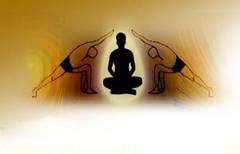
YOGA POSES FOR AGEUSIA
Shoulderstand Pose
This yoga pose is for thyroid & parathyroid glands, located in the neck region, since due to the firm chin-lock in sarvangasana their is increased fresh blood supply to this glands. This ample supply of blood increases their working efficiency. These glands regulate protein, carbohydrate and fat metabolism, affecting how human cells use energetic compounds.
Fish Pose
Doing the Fish Pose relieves stiffness of the neck and shoulder muscles and improves flexibility of your spine. It is the counter-pose of the Shoulder stand. Hold the Fish Pose for at least half the amount of time you spent in the shoulder stand in order to balance the stretch.
Lion Pose
Helps bring blood flow to sore throat and head cold for quicker recovery. Place hands on thighs with knees bent. Spread fingers as wide apart as possible. Open mouth as wide as you can, stick out tongue as far as you can, open eyes as wide as you can without blinking. Hold this posture until your eyes start to water, staring at one spot. Repeat until your eyes water a lot.
Sun Salutation
Sun Salution is one of the more common postures within Yoga. This particular exercise not only stretches your spine and joints, but also works to regulate your breathing, calm your mind, and energize your body. Generally, Sun Salutation is used to begin a set of Yoga exercises. You can use it to begin your day.
Pranayama
Pranayama or Breathing Exercise which promotes proper breathing. In a Yogic point of view, proper breathing is to bring more oxygen to the blood and to the brain, and to control Prana or the vital life energy. Pranayama Yoga also goes hand in hand with the Asanas. The union of these two Yogic Principles is considered as the highest form of purification and self-discipline, covering both mind and body.
YOGA ASANAS FOR AGEUSIA
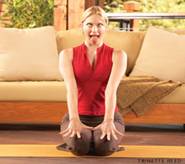
SIMHASANA
This is wonderful pose for gaining courage and lightening your emotional load; the facial expressions involved are guaranteed to boost your mood, especially if you perform this pose in front of a mirror.
Steps
• Kneel on the floor; keep your knees about shoulder-width apart.
• Sit back on your heels; your calves should be flat on the floor.
• Spread the knees apart a little further; only move them as far as is comfortable.
• Straighten and lengthen the back and shoulders; sit up tall.
• Without rounding the shoulders, place your hands loosely on your knees.
• Inhale and lean forward slightly without compromising your straight spine.
• Stretch your mouth and jaw open as wide as possible. Extend your tongue and cross your eyes by looking at the tip of your nose; also tense and straighten your fingers out from their resting place on the knees.
• Hold this position for one breath and then relax; lean back and let your fingers drop back to your knees. Close the mouth and eyes.
• Spread the knees apart a little further; only move them as far as is comfortable.
SARVANGASAN
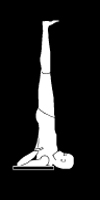
This asana is very good for the thyroid gland. This asana improves the reproductive organs in both men and women. It also helps in relieving bronchitis, dyspepsia, and varicose veins and increases digestive capacity. It stimulates the thyroid and para-thyroid glands and influences the brain, heart and lungs, and improves blood circulation. However, those suffering from high blood pressure should not practice this posture. The sarvanga-asana should not be performed by woman who are menstruating, as is the case with all inverted postures (where the legs are raise over the head.
Steps
• Lie on your back with legs and arms straight, feet together and palms on the floor beside your body. While exhaling, raise your legs slowly upto 90 and then the whole body and the rest your weight on the arms so that the chin touches the jugular notch.
• Bring the arms and hands to support your body at the hip region (fingers at the back and thumb in front of the body). The entire weight of your body rests on the head, neck and shoulders while the arms are used for balancing.
• Keep the trunk, legs and hips in a straight line and as vertical as possible Focus your eyes on your toes, with your chin pressed against the chest. Retain the posture for one for three minutes.
• While exhaling, return to the lying position by bringing the leg backward and releasing the hands and the palms.
MATSYASANA
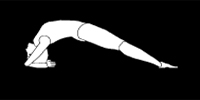
This asana is very useful for persons suffering from chronic cough, bronchial asthma, congestion, infected tonsils and other respiratory disorders. Problems relating to thyroid and para-thyroid glands can also be overcome be done to derive the full of Sarvangasana.it is recommended that you breath while holding it for between two and four minutes.
Steps
• Sit with your legs fully stretched out. Bend each leg at the knees and place your feet on the other hip joint. Both the heels are adjusted in such a way that each presses the adjacent portion of the abdomen. This forms the foot-lock in a sitting position.
• Bend backwards and, exhaling, rest your weight on the elbows. Push your neck backwards and slightly rise the hip upward thus making an arch of the spine.
• Then, by making hooks of the forefingers, hold your toes on the corresponding side without crossing your arms.This posture should be maintained for some time with slow and deep breathing.
• For reverting to the original position, release the foot-lock and return to the supine position by lowering the arch.
SHIRSHASANA
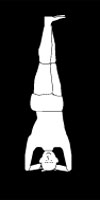
Sirsasana meaning headstand is considered to be one of the most important yoga poses. Sirsasana is known as "the queen of poses", and the reason relates to the effect it has on the brain and mind. The inversion of this pose causes increased and unrestricted blood flow to the brain. This brings increased oxygen, nutrient and vitality providing energy to the mind, clarity of thought and ease of concentration.
Steps
• Start by placing yourself opposite to a wall. Sitting on your legs, bend the elbows and place hands on opposite arms.
• Lean forward and place the elbows down perpendicular to the floor.
• Without moving the elbows open the lower arms into a triangular shape, creating an 80 degrees angle. Keep fingers interlocked.
• Place the crown of the back on the floor supported by the hands. Keep the hands on the back of the head.
• Straighten the knees and walk towards the body, raising the upper body.
• Lift the legs up balancing the legs on a wall to start with until you can balance your body up without falling onto your back. Bring feet away from the wall keeping the knees up straight. Breathing normally, concentrating on the breathing for balance.
• Keep the pressure away from the head supporting the body weight mainly with the forearms. Hold this posture for about 3 to 5 minutes to obtain maximum benefit. To come out drop the legs down gradually and rest in the child pose for at least 10 seconds.
ASTROLOGY
Yoga is an adaptive discipline that can support the body through the myriad of biological changes it is making. Importantly, it can also support our minds and emotions, and allow us to come to a perspective on the inner processes that are happening. According to astrological reports for yoga asanas the above mentioned asanas are said to be effective for those who come under the following zodiac sign.
• CANCER
• VIRGO
• LIBRA